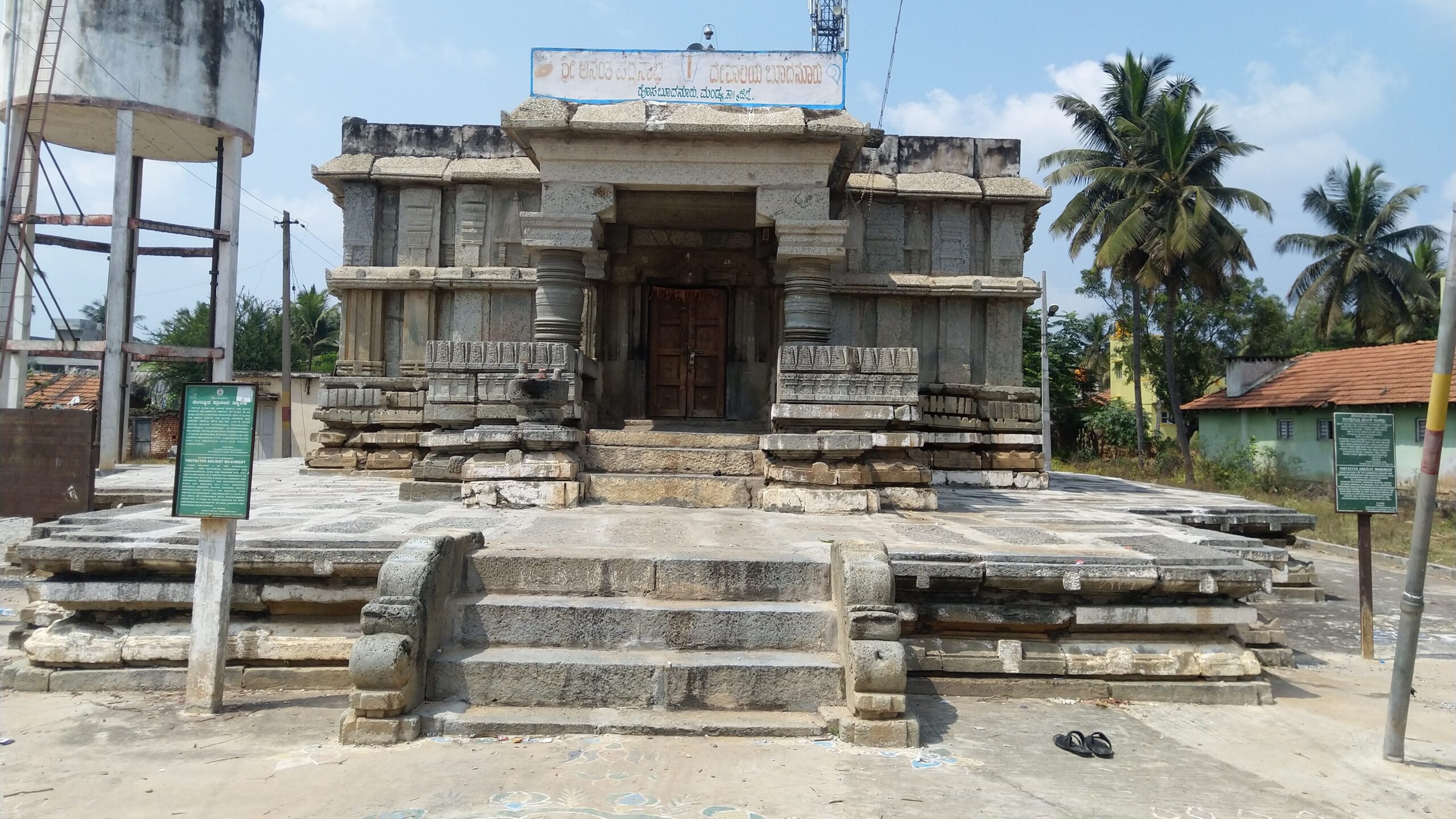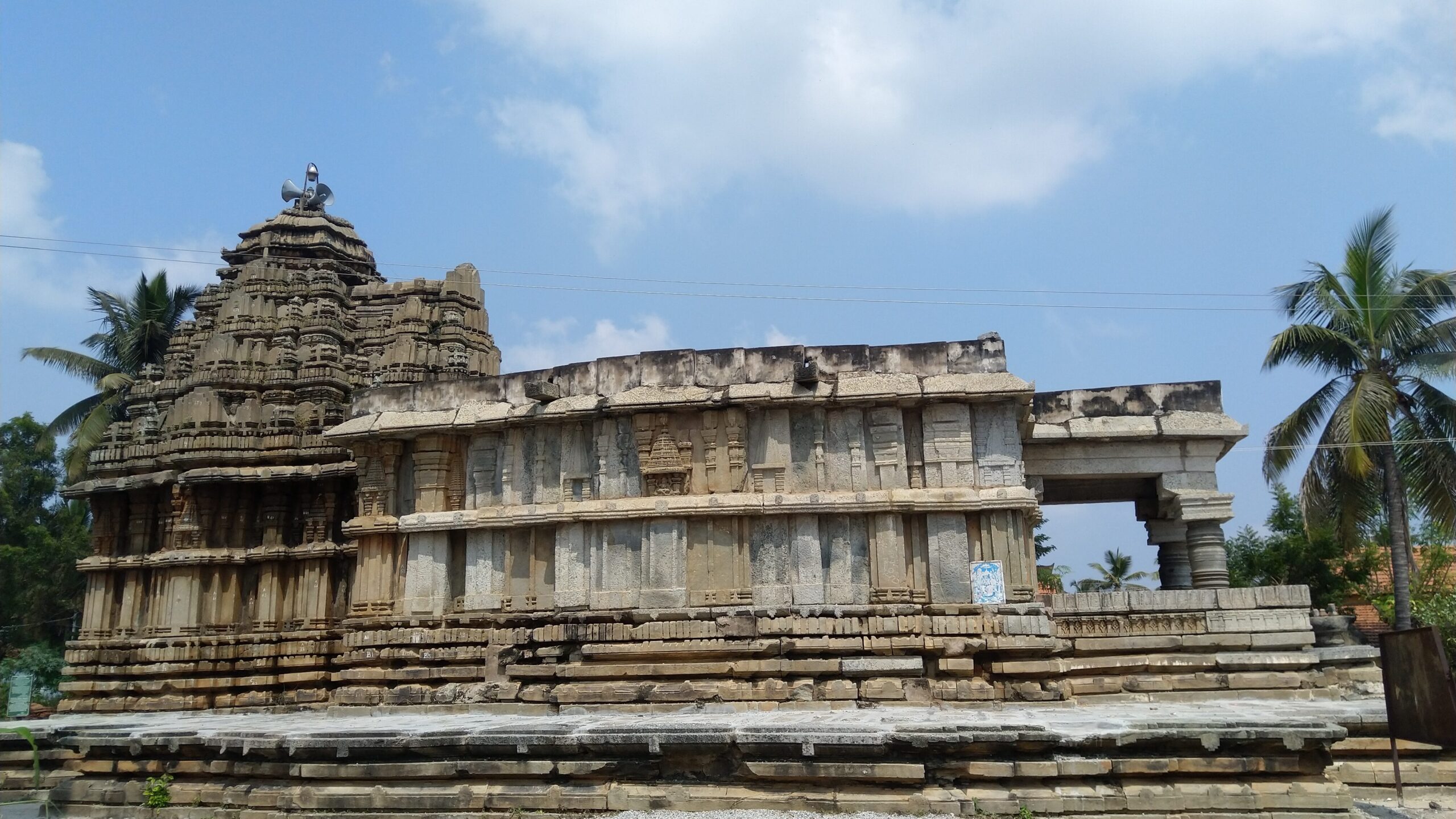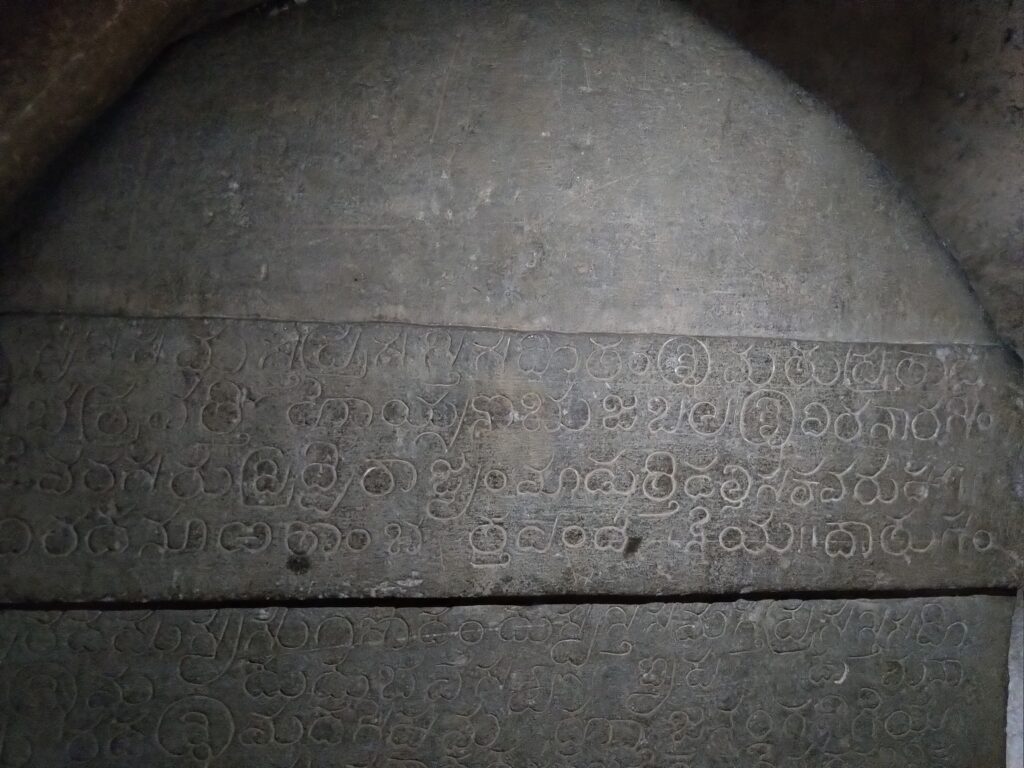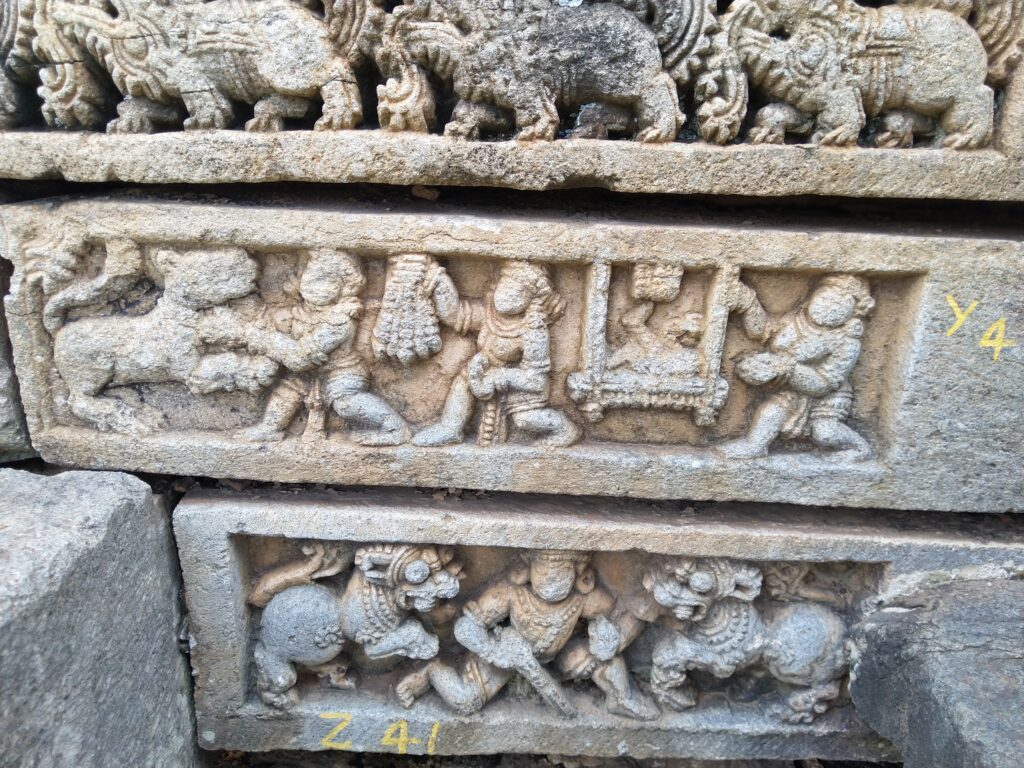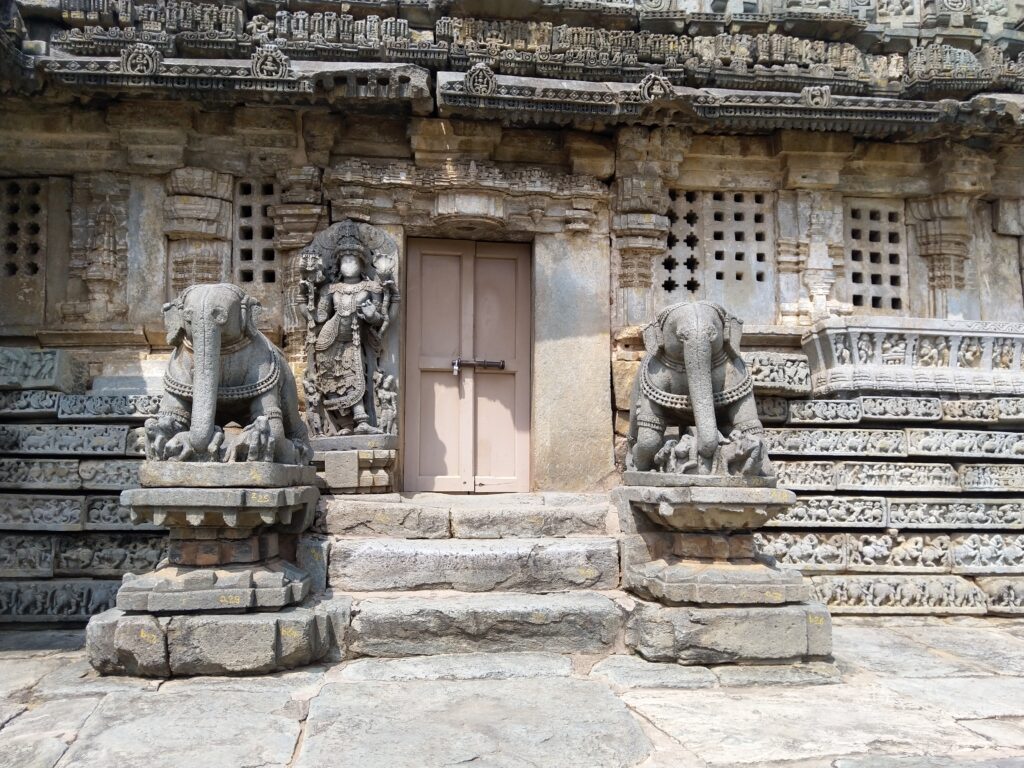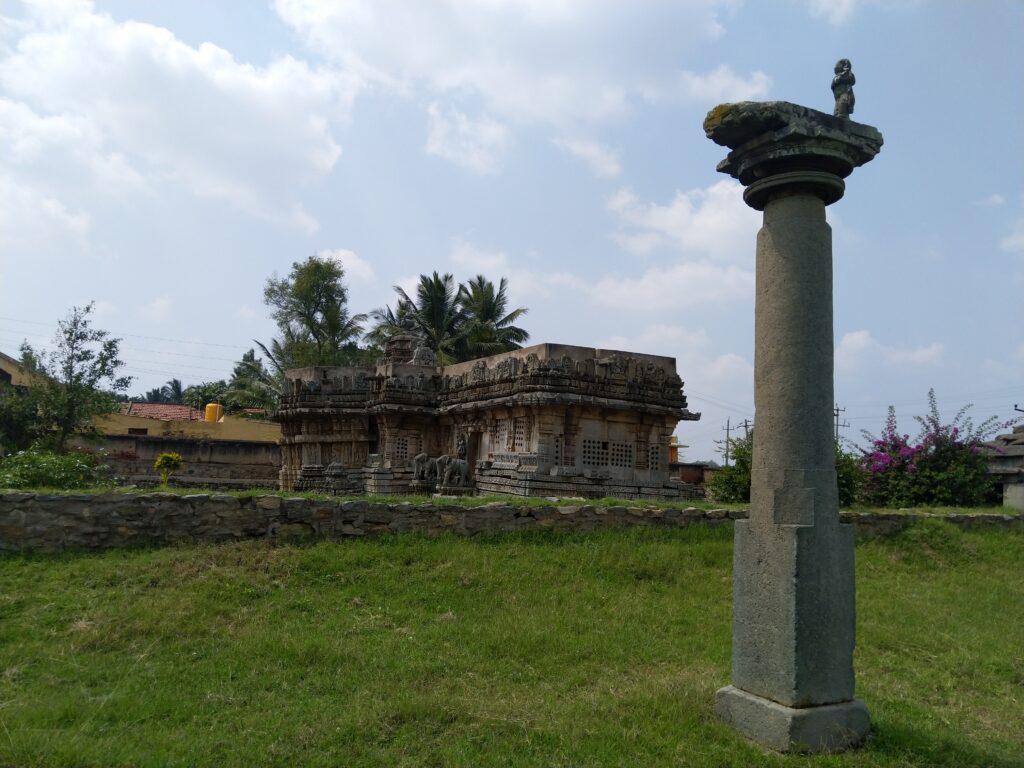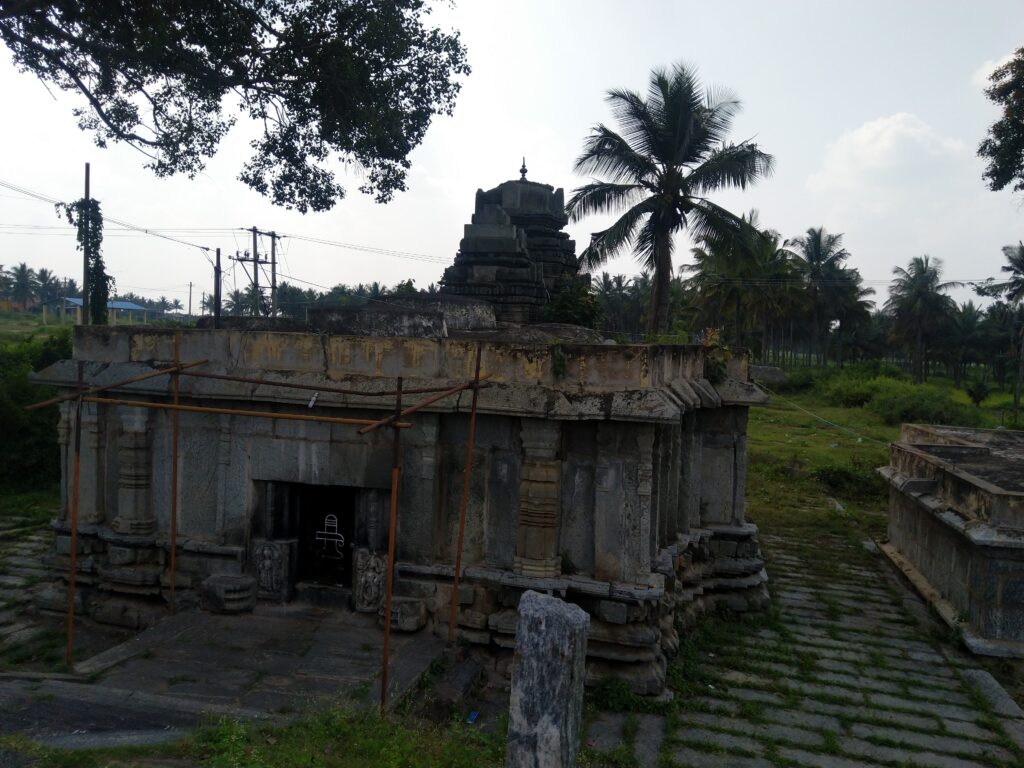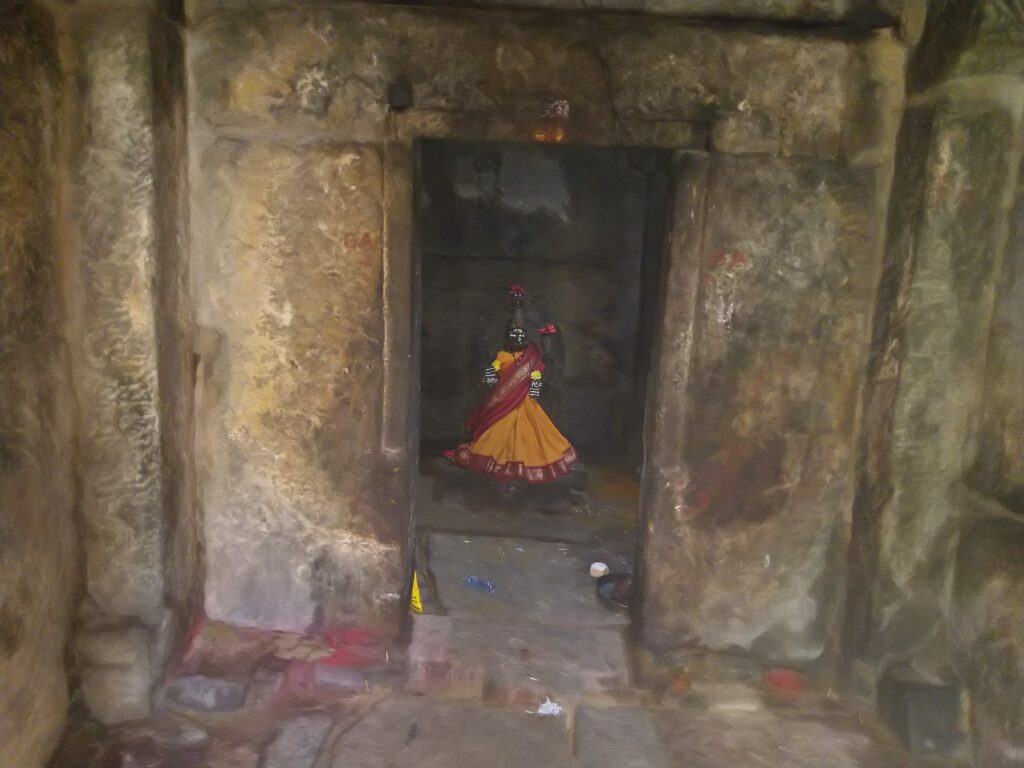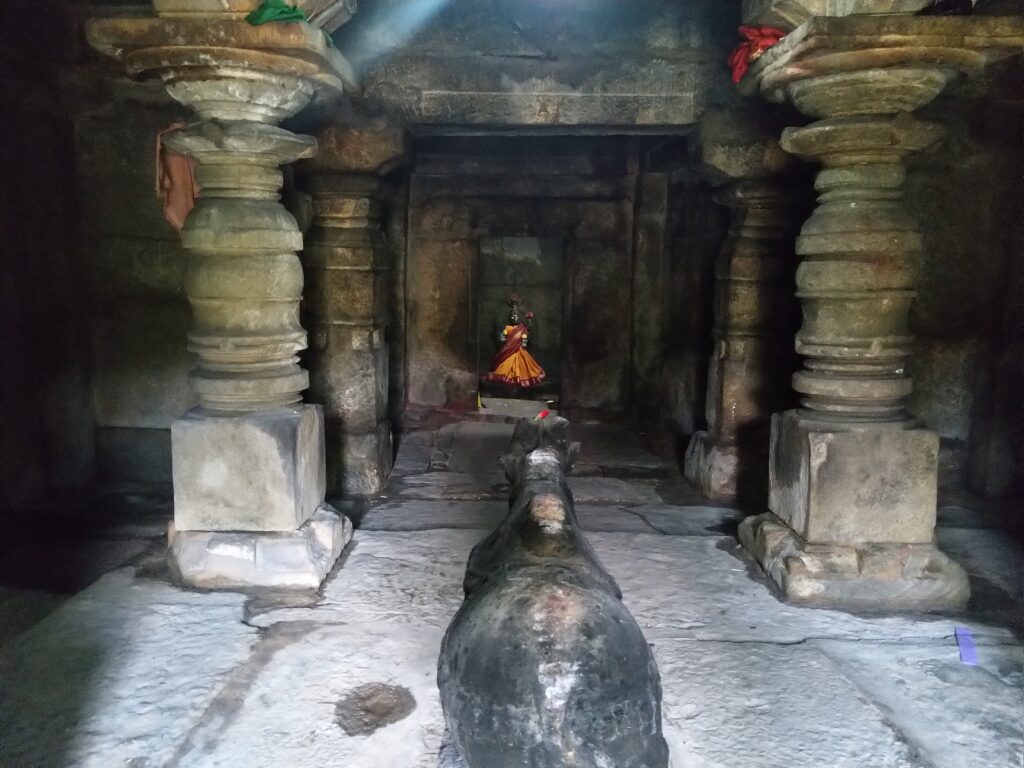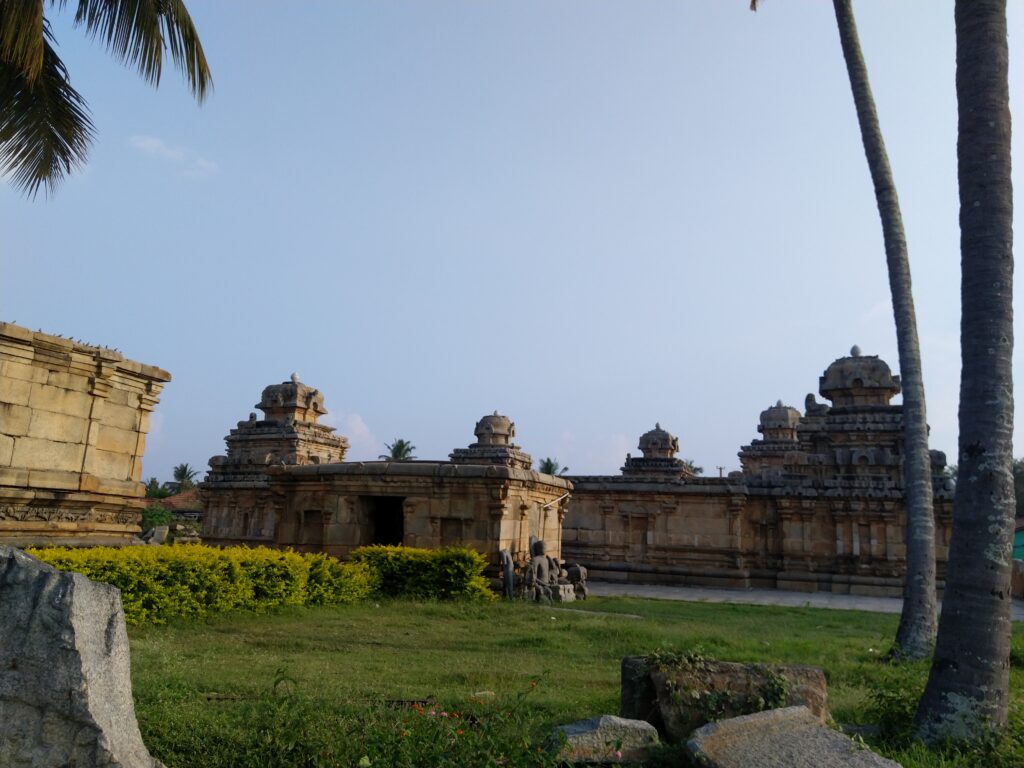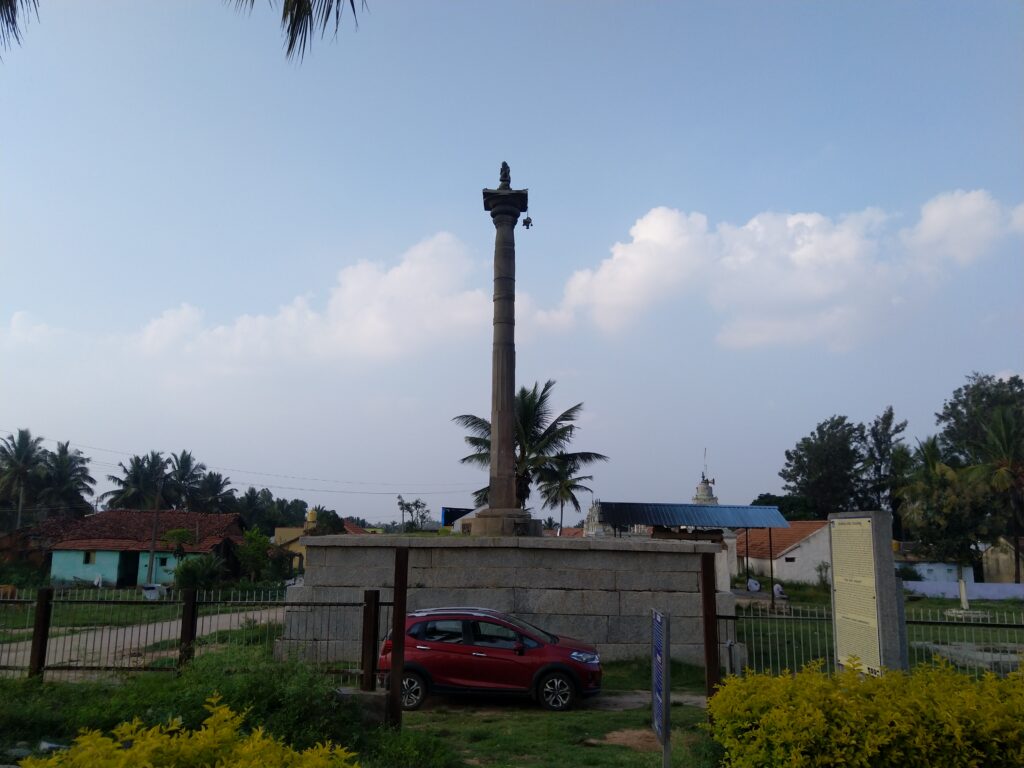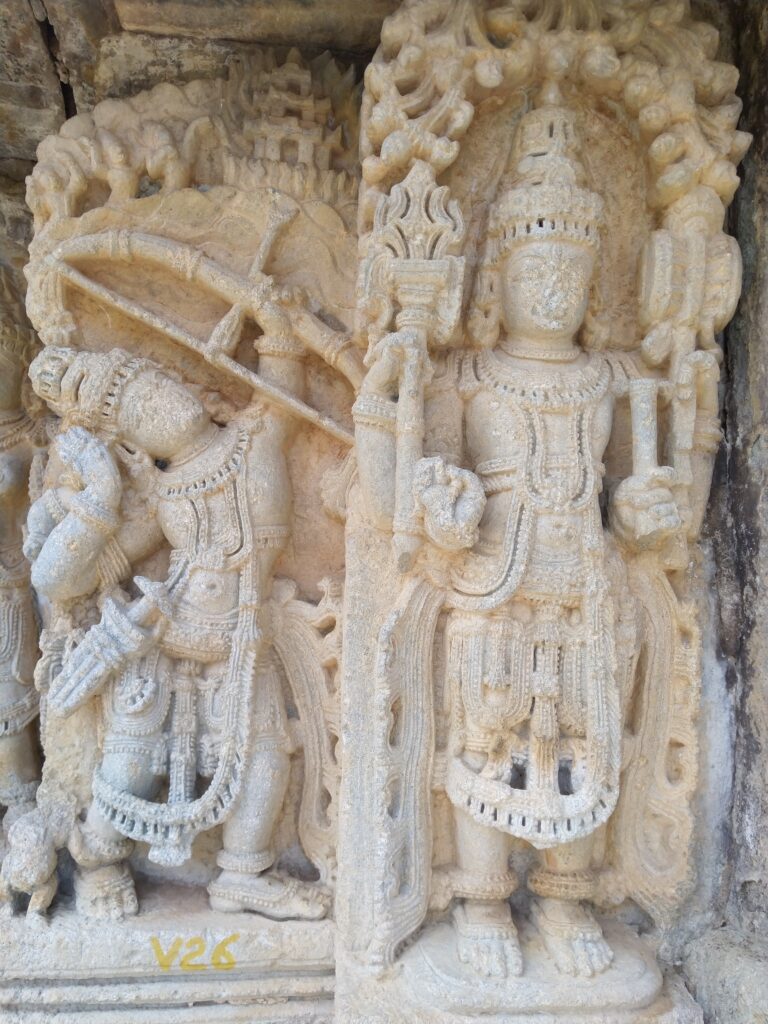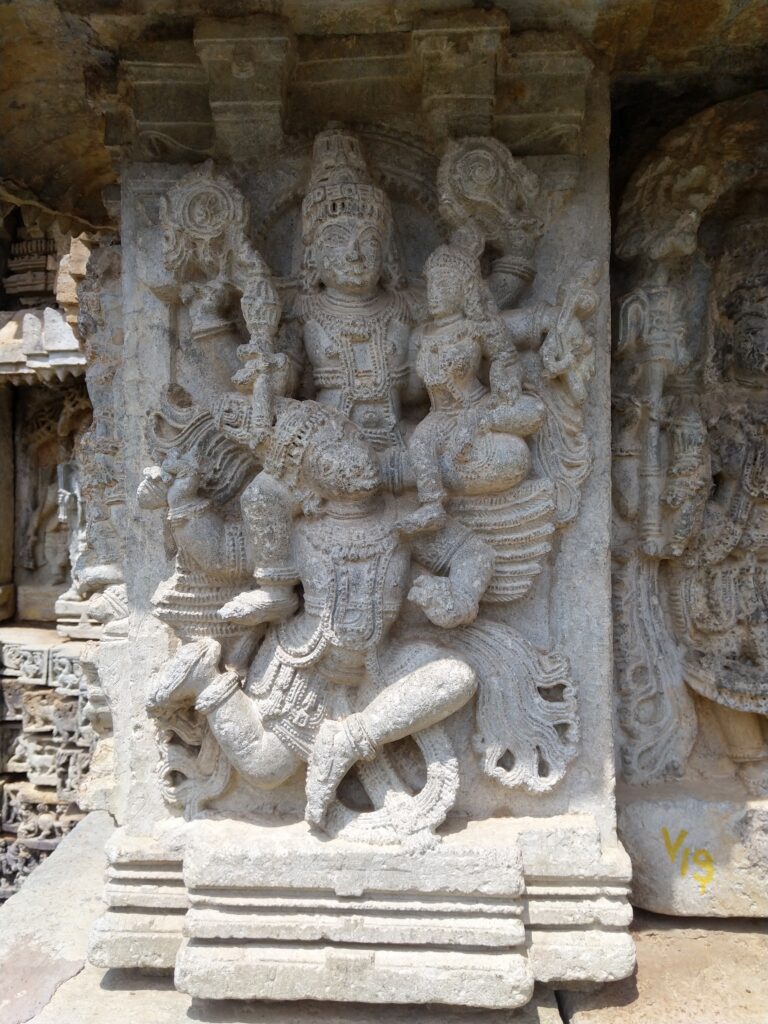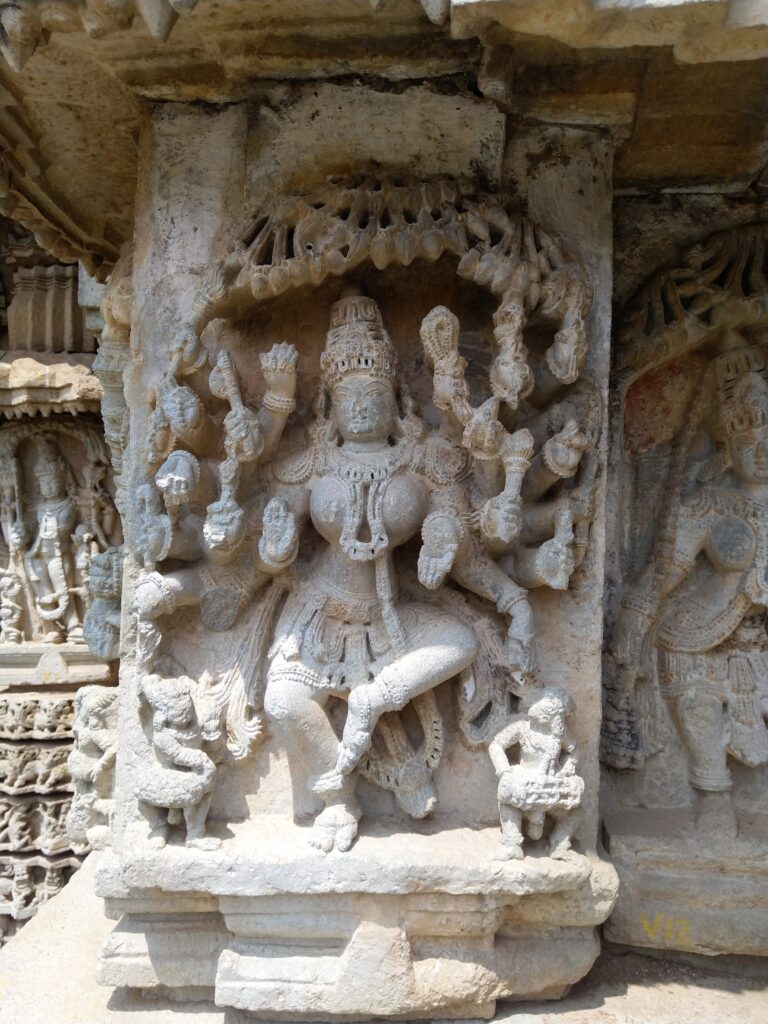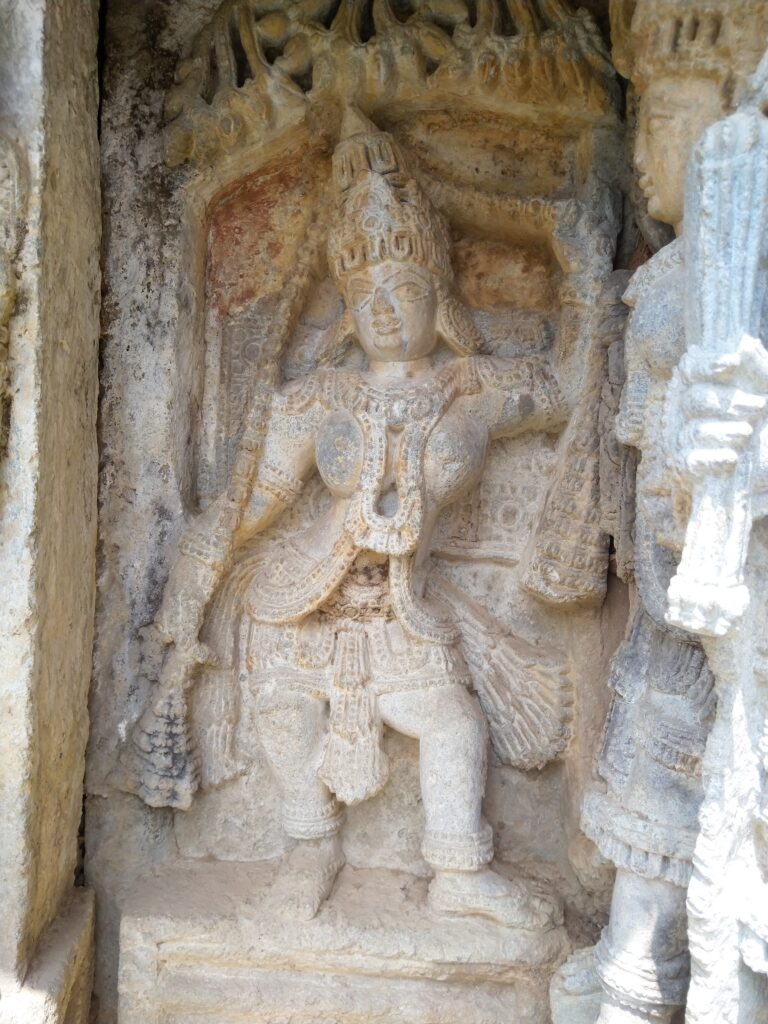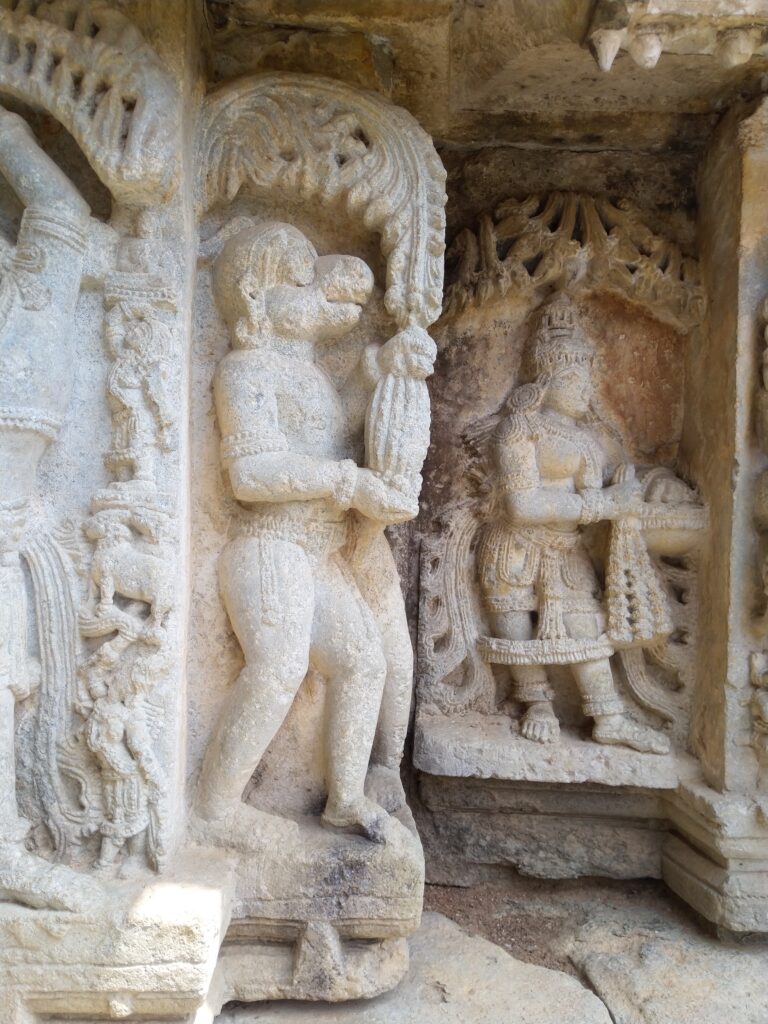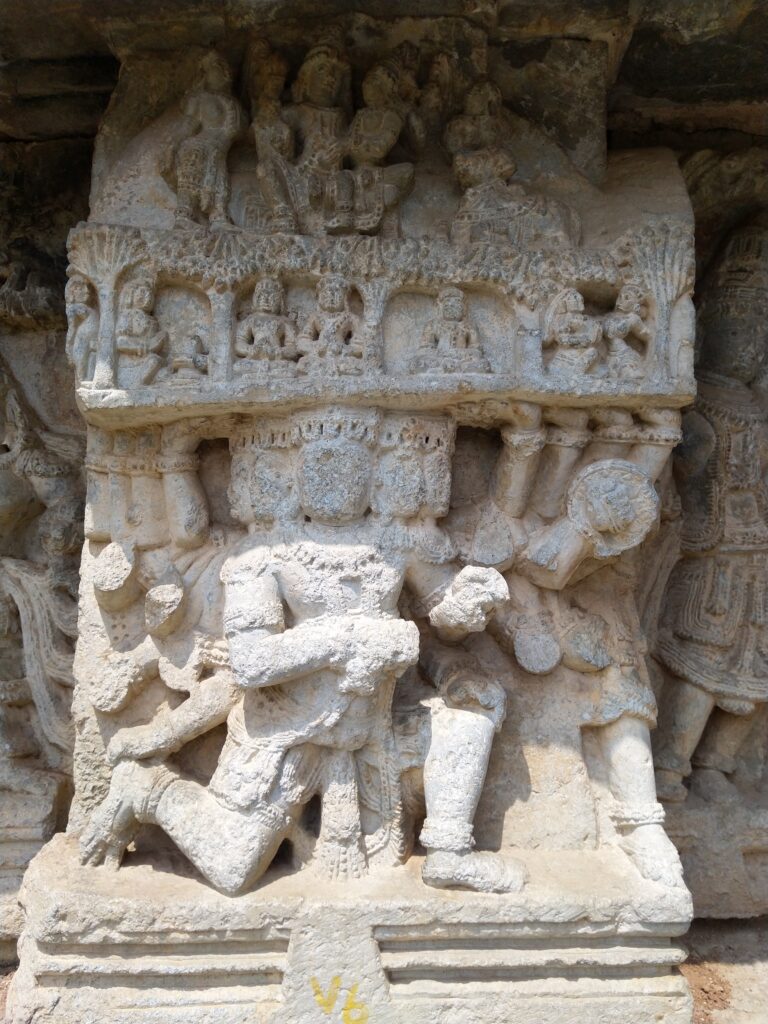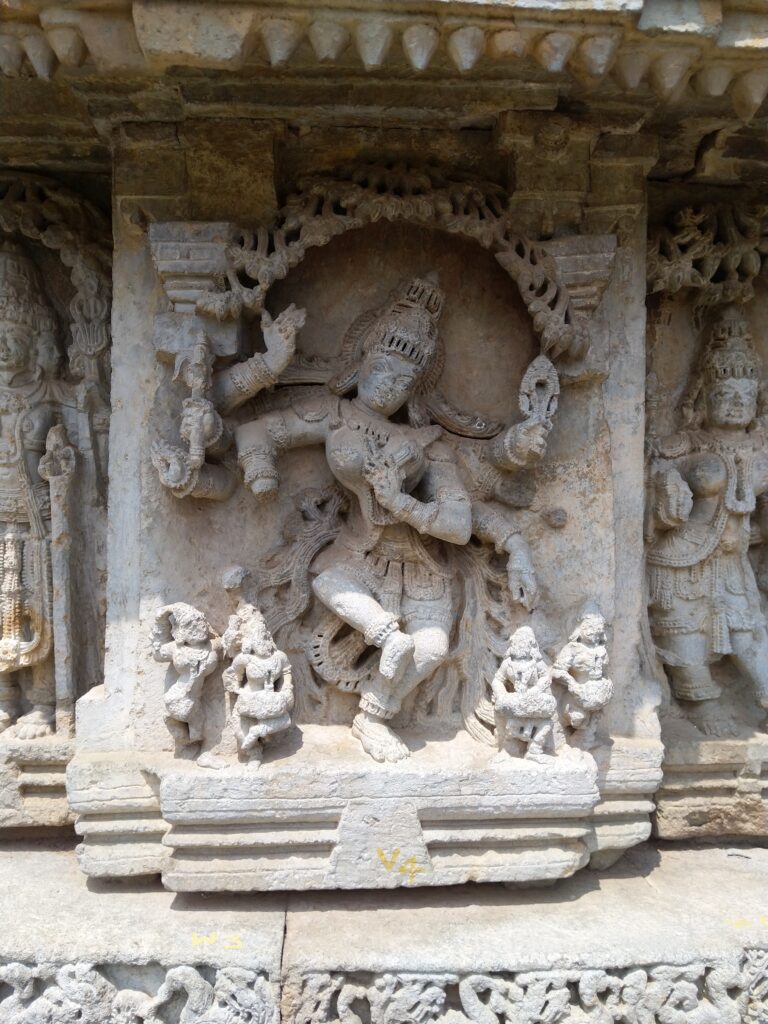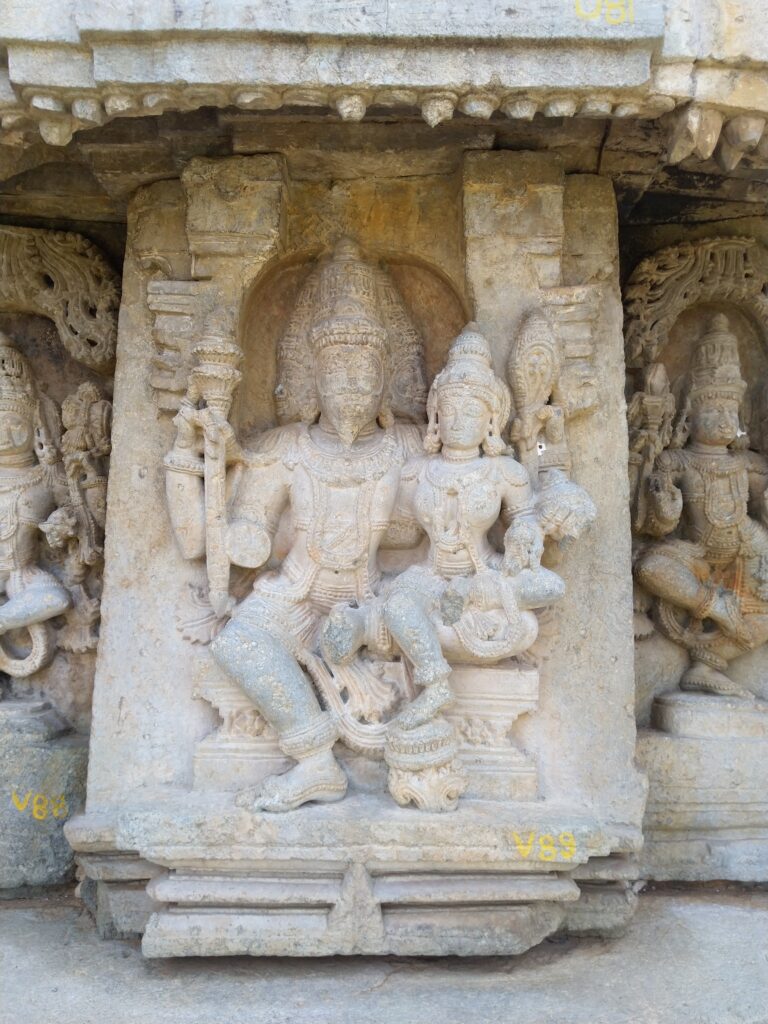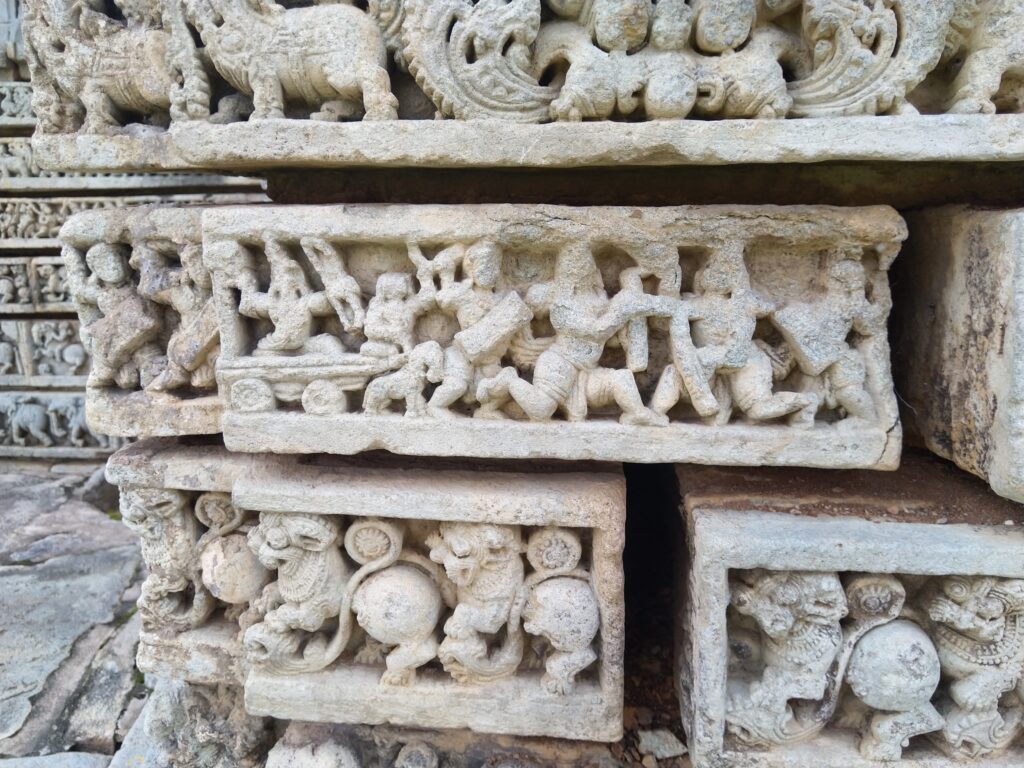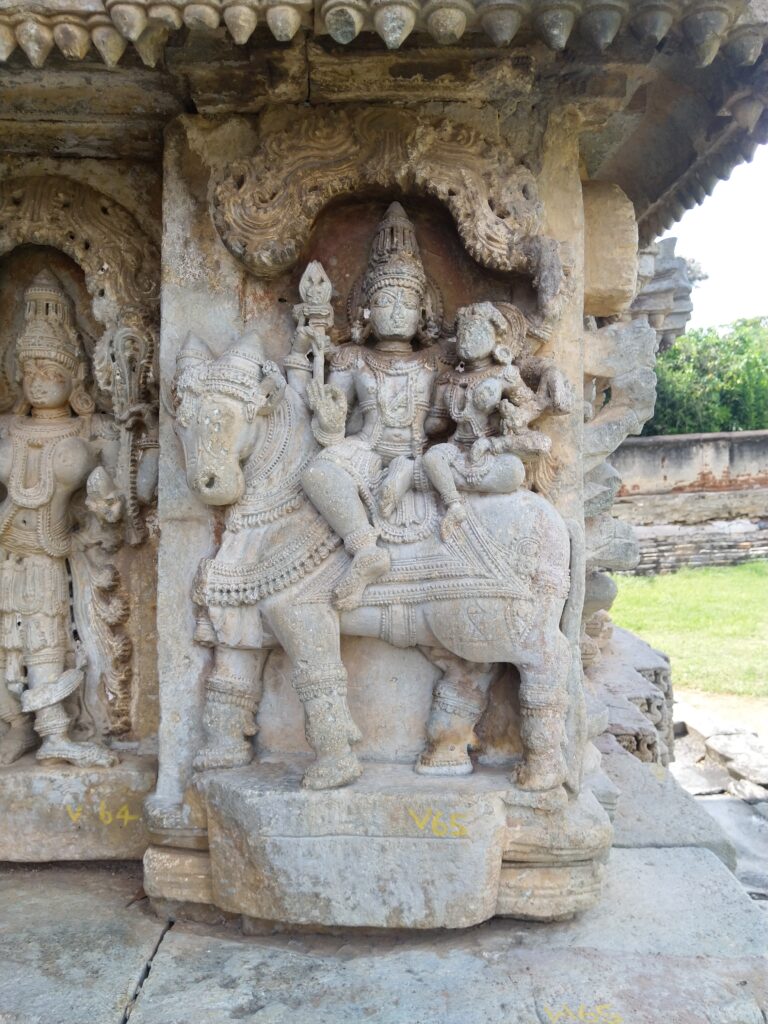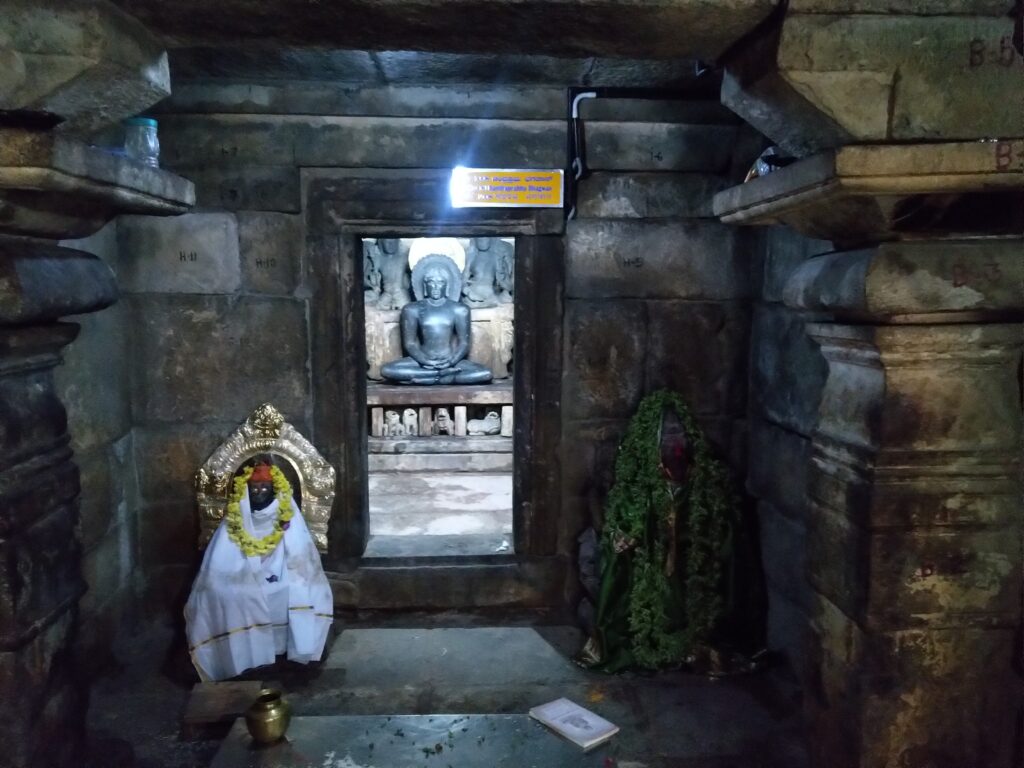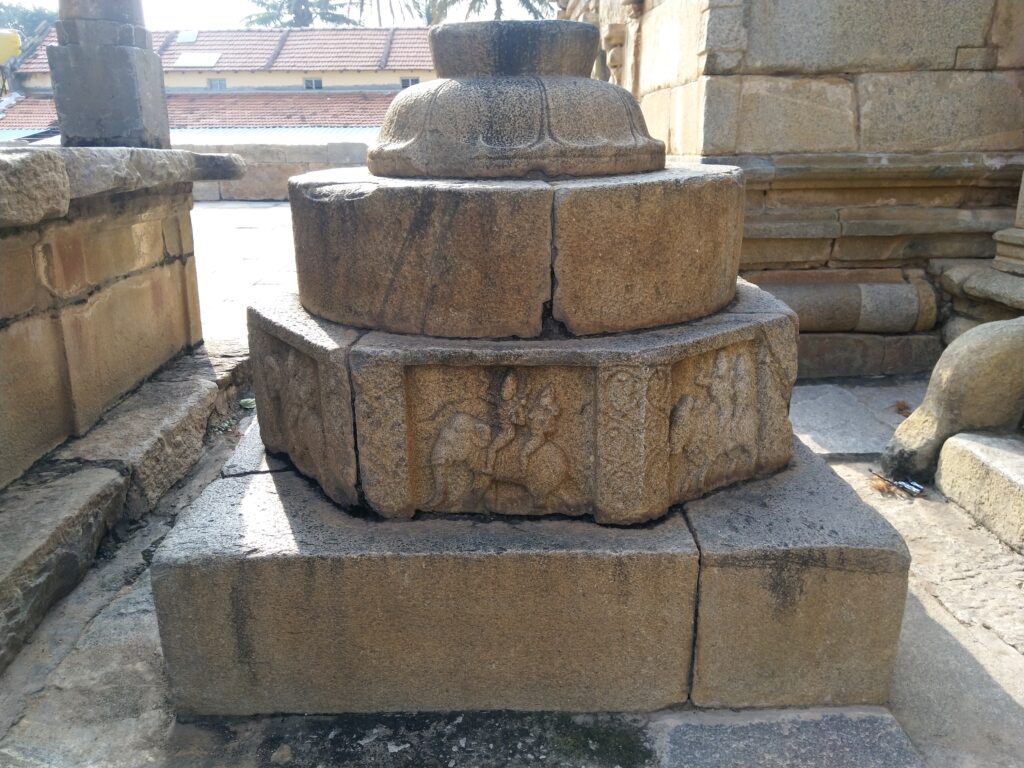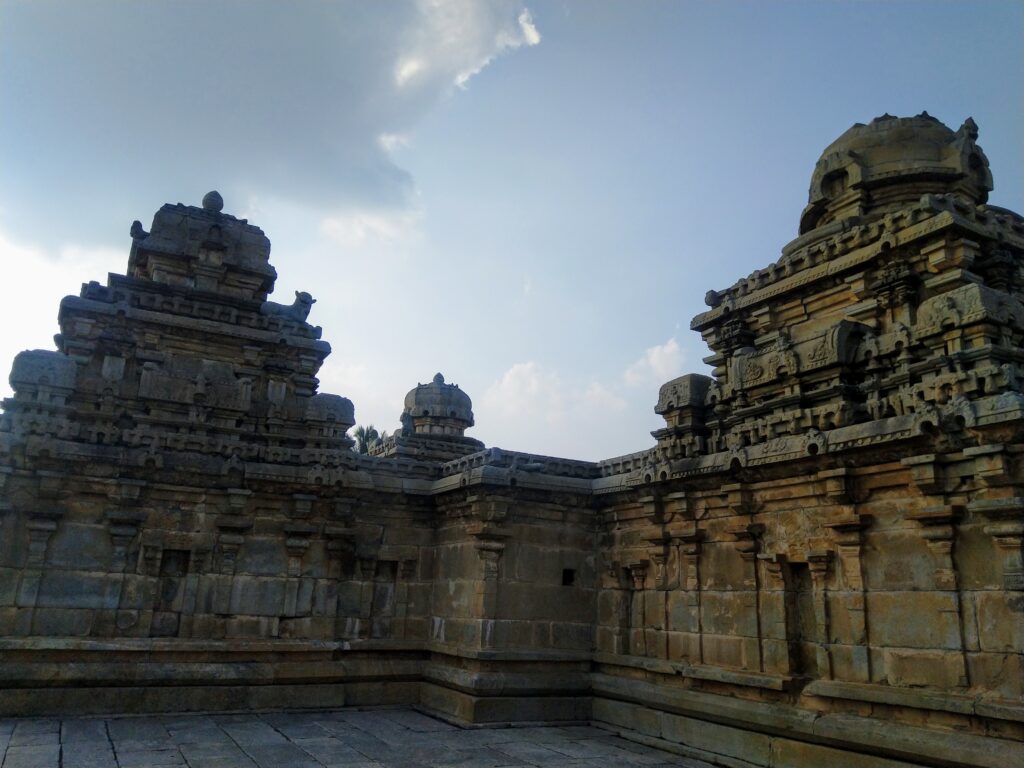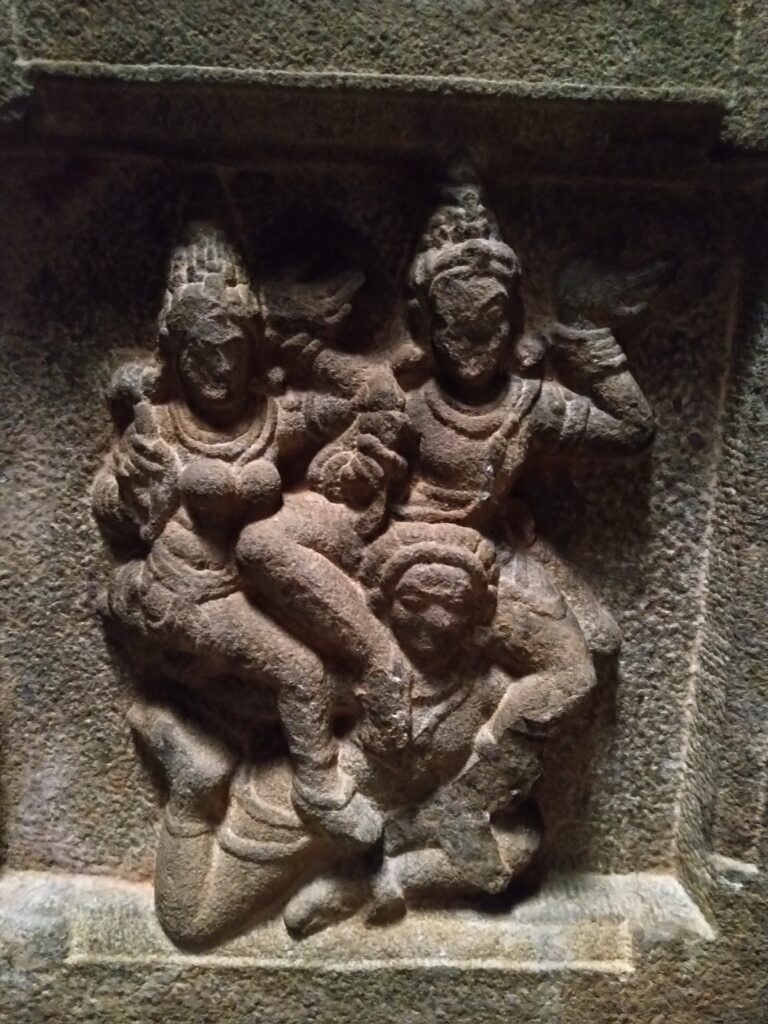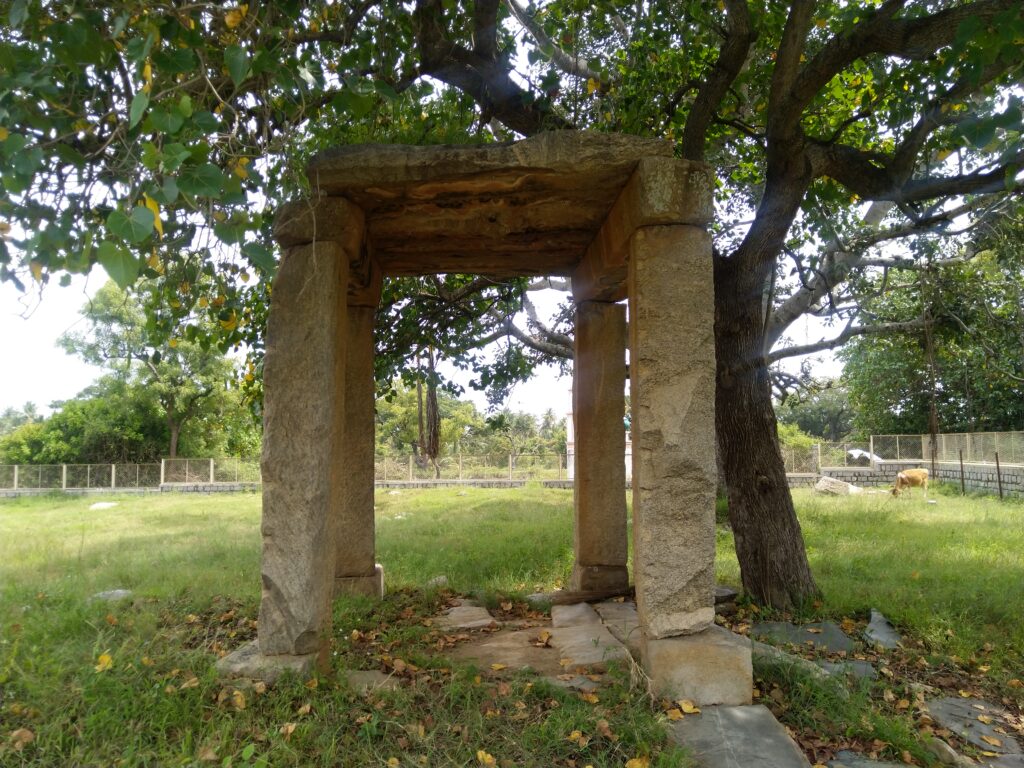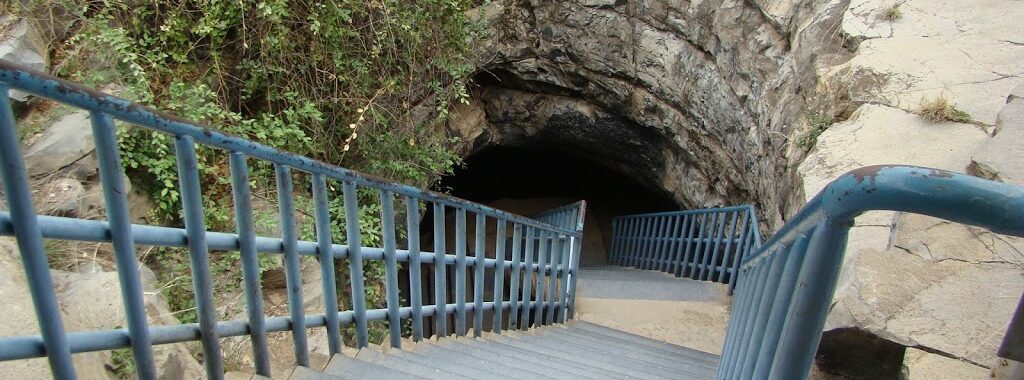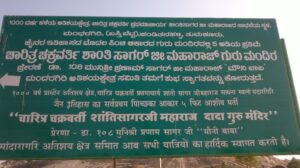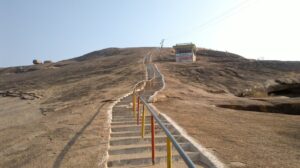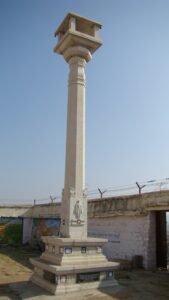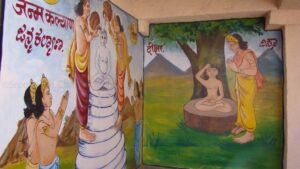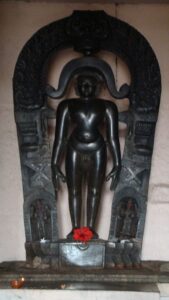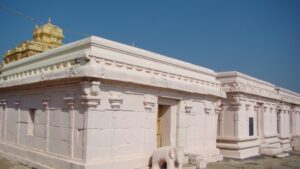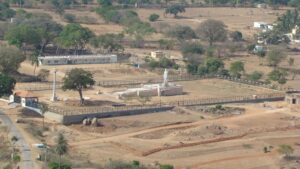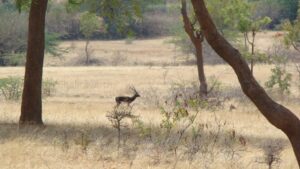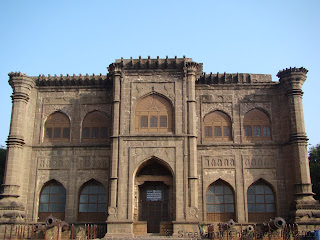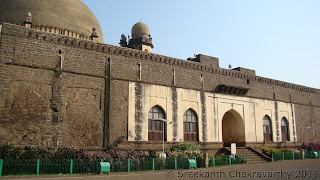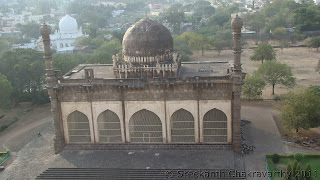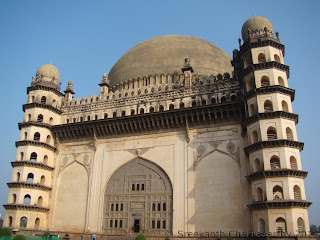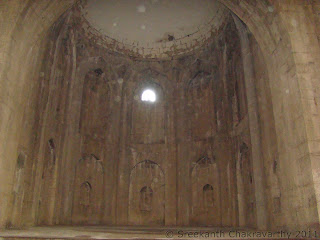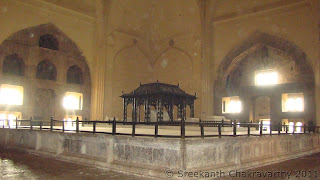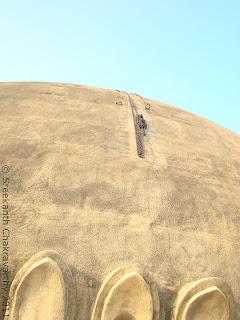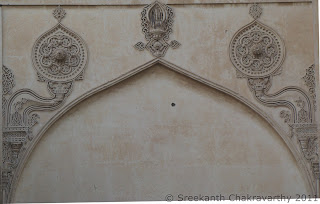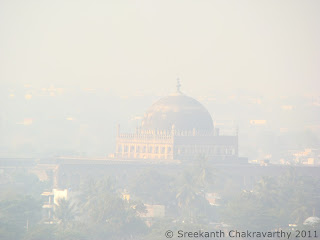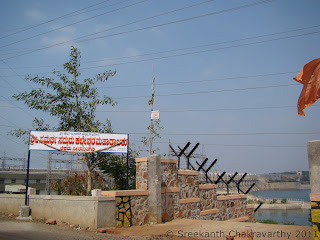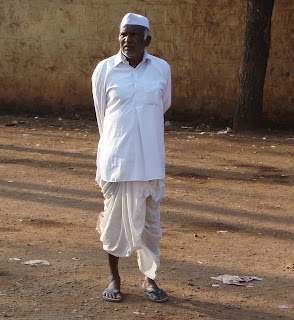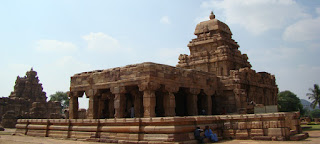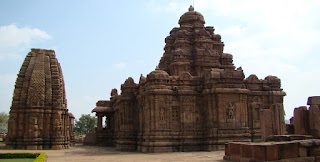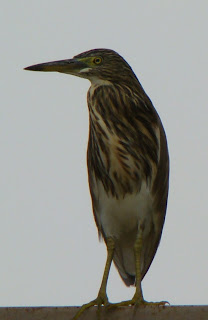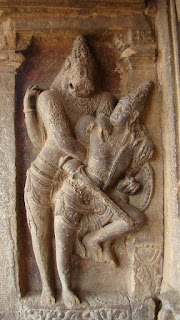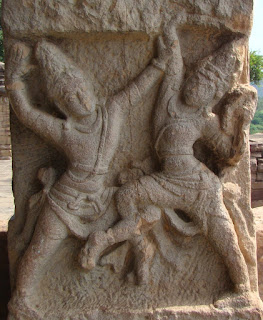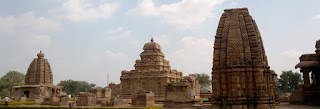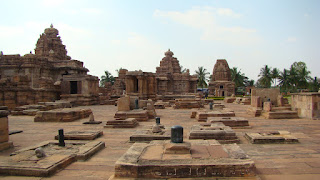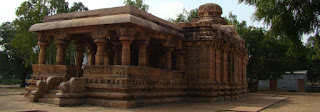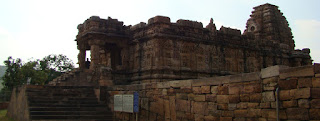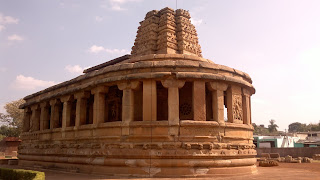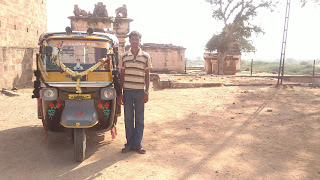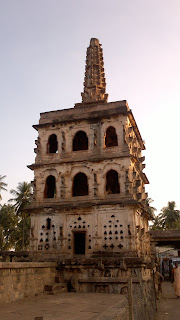Next morning, I set out towards Badami caves by 7 a.m. The caves were just 10 minutes walk from my hotel.
I was the first visitor that day. I was there even before monkeys took their positions.
The security guard at the entrance warned me that monkeys will be in anytime now and suggested that I can keep my bag at the canteen in the same complex for nominal charge of Rs.2. Wary, but to be safe than sorry, I followed his advice.
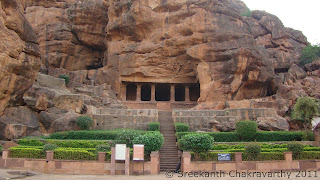
Hardly five minutes into my world of interpretation and admiration of sculptures in the first cave, a tourist guide approached me and offered to walk me through these caves for a discounted rate of Rs.200. I checked his credentials and agreed.
Whatever I write now is his version. So, take it with a pinch of salt. And no, I haven’t given away everything he told. I don’t want you guys to take a print out of my blog when you visit next time and deprive him of his means of livelihood.
The Naming Ceremony
Version 1:
Badami was earlier known as Vatapi, named after a demon by the same name. Vatapi transformed himself as a sheep and his brother served him (the sheep) to the travelers visiting this place. Once travelers had their food, Ilvala asked Vatapi to come out and Vatapi emerged out of the traveler’s stomach. Then, the brothers feasted on the traveler.
Once sage Agastya came to this place. Since he knew about the brother’s tactics, as soon as he had his food, he said “Vatapi Jeernobhava” (Vatapi, get digested). That day, when Ilvala called Vatapi, he never came out. Thus the name, Vatapi.
My take:What was this place known as before this incident? What if the traveler was a non-vegetarian? Why couldn’t the demons just kill the travelers instead of taking so much trouble?
Version 2:
The hills/ rocks in this place were formed due to a volcano centuries ago. Since these stones are of Almond color which means Badami in Kannada, this place came to be known as Badami.
My take:
This is quite possible.
The Cave Story:
Badami was the capital of Chalukyan kings. They have built four cave temples here.
- Shiva
- Vishnu
- Mahavishnu
- Jain
Every temple is carved out of a single piece of rock.
Cave 1:
Nataraja in first cave: This statue has 18 hands (9 on each side). Any random left hand-right hand combo results in a Bharatanatyam position. Thus you can see all 81 positions here making this a one-of-a-kind sculpture.
 Baby in various positions:
Baby in various positions:Two faces/ bodies depicting four positions.

Since the idea was to build temples in a single piece of rock, the sculptor didn’t continue when he saw the 2nd rock.

Other interesting sculptures here include:
- Parvati pillion riding with Shiva on his vehicle Nandi.
- Bull-Elephant combo
- Ardhanaareeshwara (pic below)
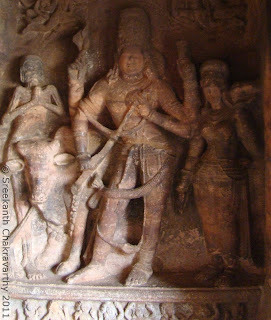
The idol of Linga still exists in the sanctum sanctorum.
Cave 2
This was built by Keertivarman, Pulikeshi’s son. This temple is dedicated to Vishnu.
Sanctum sanctorum is empty. Vandalized by Bahamani kings.
Vamana avatara of Vishnu on one of the walls

Never-ending Swastika.
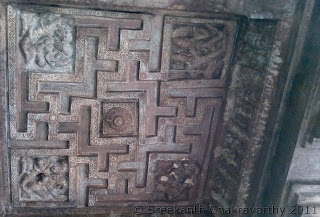
British judges stole this hairstyle idea:

Between 2nd and 3rd cave are these steps leading to Tipu Sultan’s fort on top.
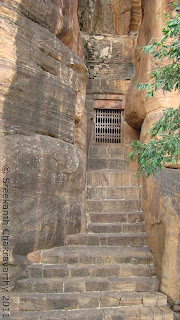

Cave formed due to erosion
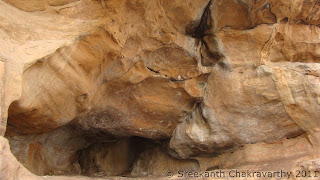
Cave 3
Built by Mangalesha, Keertivarman’s brother. Similar to 2nd cave. Nothing in sanctum sanctorum.
Narasimha avatara
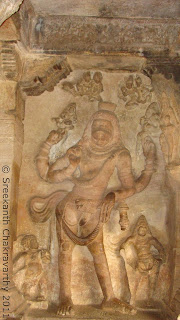 Evolution:
Evolution: Monkey from one side and Human from another.
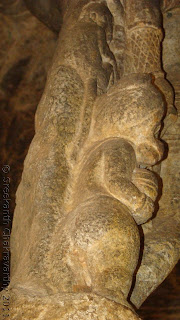
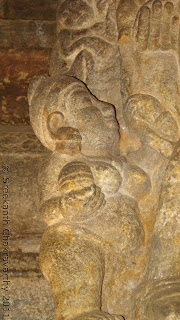
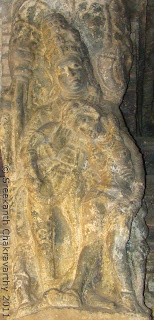
Other interesting sculptures include:
- Ashta dikpalakas on the ceiling
- Hari-Hara
- Colorful designs on the ceiling
Cave 4
Jain temple dedicated to the 24th Tirthankara of Digambara sect.
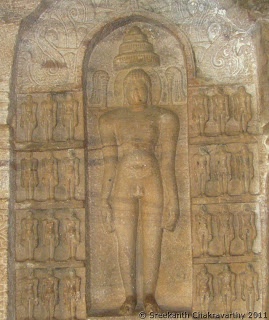
Idol in the sanctum sanctorum
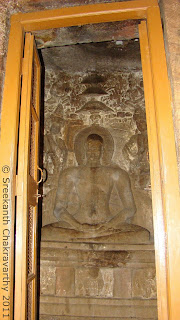
The guide left after this. I came down and headed towards the museum and other temples.
Agastya teertha
Till 1960s, the hills around this lake were full of medicinal trees. The rainwater from these hills flowed down into the lake and hence a dip here was believed to cure all diseases. Now this lake is used by washermen (meaning Agasa in Kannada) and this is known as Agasa teertha. No prizes for guessing its current medicinal value. 😀

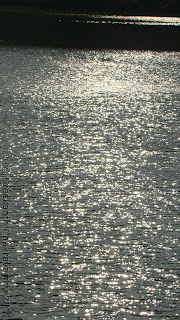

The museum was yet to open. So I walked up further towards Bhootanatha temples.
Bhootanatha temples
This is one of most peaceful places I have ever visited. I sat there for about 45 minutes and all I heard was chirping birds and few washermen busy with their duty.

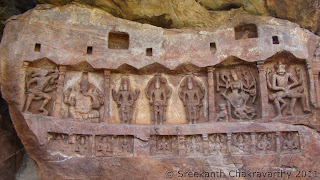
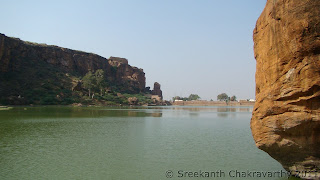

While I was taking pictures around Bhootanatha temples, I saw some sculptures dumped on the nearby hill. Even these are vandalized. But I don’t think Bahamani kings are to be blamed for this. 😛
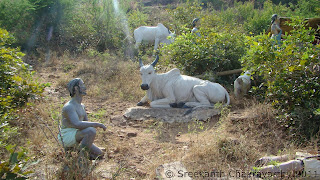
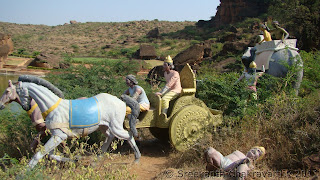

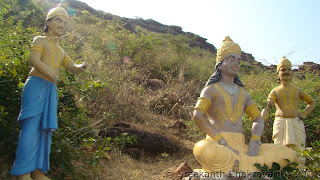
I was back at the museum by 10.30 a.m. I generally find museums very boring. But this one has some excellent stuff and I was glad that I didn’t give it a miss. After spending a good 15-20 minutes there I set out towards hilltop temples.
On the way…
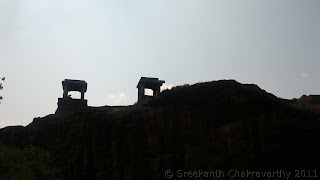

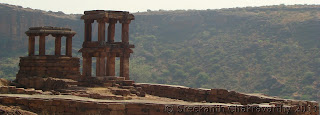
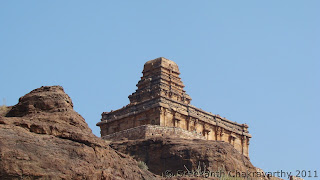


The temple at the highest point
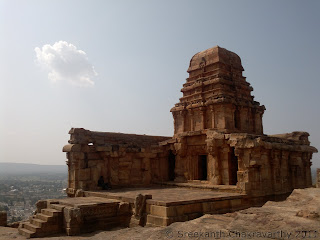
View from the top
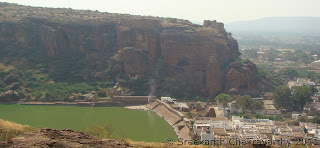
When I walked down, it was 11.30 a.m. I collected my bag from the canteen, sat there for few minutes having tea and snacks and set out towards my deal-clinching leg of Bijapur.
There are very few direct buses to Bijapur from Badami. The best option is to go to Kerur and then get a bus to Bijapur from there. The bus to Kerur started at 12.45 p.m. So did my thoughts. Overall, I was satisfied with my visits over the last two days. I rated Badami the best of the lot and wouldn’t mind visiting again after 3-4 years.
I reached Kerur at around 1.15 p.m. The road was good and there were very few stops in between. The Hubli-Bijapur bus reached Kerur as soon as I got down from my bus. I just confirmed with the driver and got in. On the way, I saw some people selling curd in a small pot. Wish I could buy one.
Bijapur
I reached Bijapur at 3.30 p.m. I checked with a couple of people and they said that I can cover Gol Gumbaz and Bara Kaman that evening. I also booked a ticket to Bangalore next day.
My first destination was Gol Gumbaz. The cheap and best mode of transport to reach there was the shared auto from a circle which was about 7-10 mins walk from the bus stand. I reached Gol Gumbaz at 4.00 p.m. I was completely shocked as soon as I walked through the gates. No, it was not the massive Gol Gumbaz. It was the parking lot. The sight of so many vehicles – buses of various capacities, Tata Sumo, Safari and every other tourist vehicle I can think of made me wonder if I made the right decision by coming here. But I still decided to go. Worst case, I will come again next day.
I saw people everywhere on the way to the main tomb – people came here for evening walk, picnic, and of course, being weekday evening, kids with various intentions. As expected, most of the crowd was inside Gol Gumbaz.
As I mentioned in my earlier post, Gol Gumbaz is famous for its whispering gallery. Every word uttered in this gallery echoes 7 times. And the keyword here is “whisper”. But imagine the chaos when you have about 150 people testing this? Or when a school teacher asks his team of about 70 kids to clap together (discipline factor) to hear the echo? Gol Gumbaz had turned Ghor Gumbaz.
I walked out of the tomb in less than 15 minutes. The guy manning the footwear said that if I really want to experience whispering gallery, I should be here by 6 a.m. He also helped with the plan for evening. If I can hire an auto, I can cover four key places that day itself. Considering the distance and time, the best deal would be at Rs.200.
I was back in front of Gol Gumbaz gate at 4.45 p.m. I cut a deal with an auto guy for the recommended fare and headed towards Bara Kaman first.
Bara Kaman
This was being constructed by the son of king who constructed Gol Gumbaz. However, the construction stopped when he died in a war. Now all we can see are these arches. If it had been completed, it would have been taller than Qutub Minar, currently India’s tallest monument.

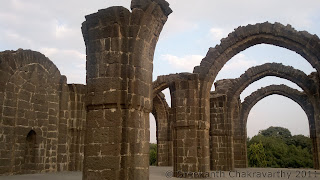
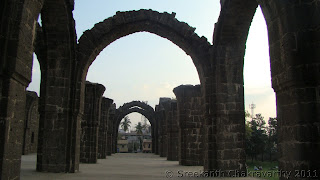
Upli Burj
There is nothing much to see here.
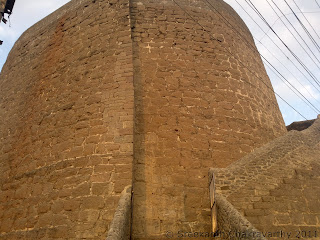

Malik-E-Maidan a.k.a Topu
Got a guide here, though I hardly had any time to spare. This place is famous for the cannon British wanted to shift to England. But this cannon was so heavy that they gave up after bringing this down by just one floor.

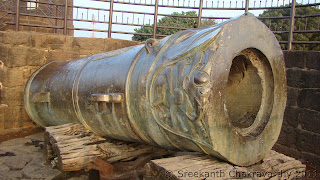
Some trivia about this cannon:
- Made of panchaloha(combination of gold, copper, silver, iron, and lead).
- Won the battle of Talikota in which Vijayanagar empire was wiped out. Locals worship this twice a week even today.
- A single shot from this cannon killed 200 people.
- Has a design of Elephant body with horse legs depicting its power and speed.
The king who built this was a very religious tolerant person. The proof of this is the pic below that has a moon representing the Islamic religion and sun for Hinduism.
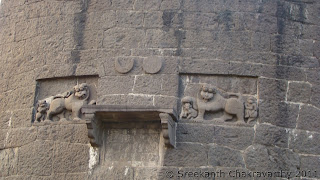
This tower was one of the entrances of Bijapur fort. So there is a moat (which used to be full of crocodiles) around this as the first line of defence and small holes in the walls to fire at enemies who manage to cross the moat. If the team here wanted reinforcement, they used to clap here (see the square in the pic) and the regiment stationed at Upli Burj, located about 300 metres away, heard it and responded.
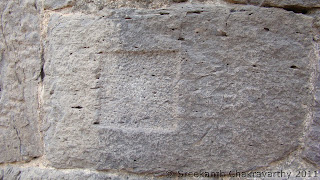
Ibrahim Roja
This tomb of Ibrahim Adil Shah inspired Shahjahan’s Taj Mahal. Need I say more?

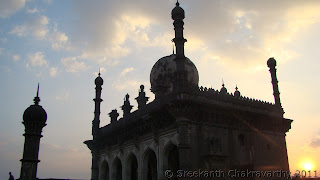
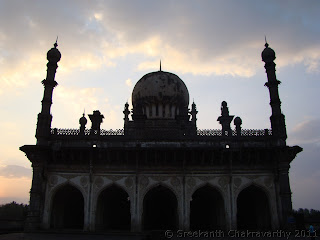
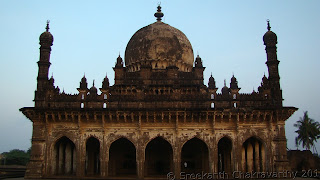
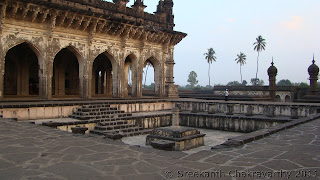
I came out of Ibrahim Roja by 6.00 p.m. and reached the bus stand by 6.15 p.m. I checked into Yatri Nivas (Karnataka Government’s budget lodges) in the bus stand complex. It offered a single room with TV, fan and hot water for Rs.250. Exceeds Expectations.
A great day ends.
Sidewing:
The best quote from my Badami guide: GOD – Generator, Operator, and Destroyer.
It is worth hiring a guide in Badami. Their explanations might not be entirely true, but it definitely helps in understanding and appreciating the craftsmanship of Chalukyan era architects. Trust me, I have shared only half of what my guide told in this post.
One needs to pass through narrow-laned residential area to get to the museum and Bhootanatha temples. Watch out for the small signposts to make sure you are on the right path. Or even better, ask locals. Most of them can understand Hindi.
Bijapur is also known as Vijapur. Many buses use the latter on their boards. In any case, just check before you get in, just like I did.
If you are carrying any digital camera (this includes any non-reel camera, not just DSLR), get the camera coupon at Gol Gumbaz. The guy at the entrance of main tomb will not allow you to take it inside without that ticket.
Bags are not allowed inside Gol Gumbaz. You have to leave it at the guy manning the footwear. As far as possible, leave it in your hotel room.
